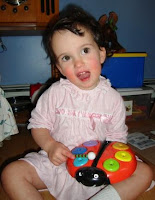
As we do this, pointers the Creative Curriculum® offers are:
- to offer fewer materials at the outset, allowing time for children to learn to use and care for them (Do I hear echoes of Montessori here?)
- to minimize sharing problems by putting out duplicates of basic materials rather than a large selection of different items (This is not really something I intend to do regularly with two, soon to be three, children, but it is a thought for those with more... That being said, for Montessori followers, this suggestion runs counter to Montessori philosophy and practice.)
- to include simple, familiar materials such as stringing beads, crayons and puzzles (Reggio aficionados, especially, can appreciate the amazing things children can create and discover using quality materials and recycled, re-purposed ones!)
Obviously these pointers are mostly consistent with other education philosophies I am interested in. Yet, admittedly, they are ones I sometimes forget to heed – often putting out too much at one time or offering too many unfamiliar or new materials and activities at once. Thus, as I continue on our Order in the Home quest, getting excited about the variety of materials we have collected that I am uncovering as we move along, and as I delight in the newly improved spaces I create, I continually remind myself to pay better attention to these pointers, remembering a tried and true maxim – less IS more!
And, with this axiom in mind, I’d like to stop thinking and start doing again – this time by creating a better learn-and-play space in our small yard for my children. Spring has sprung with summer-like weather in our area and we seem to be outside for hours and hours each day. This precludes me from doing as much with the Order in the Home(school) opens the door for examining and improving the Outdoor Area. So, please join me soon for thoughts, reflections and assessment ideas for outdoor spaces based on the Creative Curriculum® .
In This Series:
One final note, as I have mentioned before, if you would like to join me on this CC journey, please leave comments. When thinking about materials for your own space, you might want to take a look at the Setting Up a Classroom for 20 Students at Teaching Strategies. Although meant for schools, not home, this checklist offers and idea of materials to think about acquiring as you hit spring and summer yard sales and thrift shops... Also, of course, if you want to journey with me, you can grab a copy of the CC book yourself to review and let me know what you're getting from it. Or, use my summaries and posts as a starting point for thought. Tell me how you're moving from theory to practice in your own home. Cheer me on (or give me constructive criticism) about how I am doing. Or, simply jot down whatever comes to mind. Deep conversation or silly banter -- my journeys have always been all the better for sharing both along the way. I'd love to heat about yours, particularly as pertains to materials selection today. What are your favorites? You children's? How do you present and store them?
In This Series:
- Step One: Declaring Areas for Interest in the Creative Curriculum® Home
Step Two: Spaced Out -- Thinking about Space Planning Guidelines in the Creative Curriculum® for the Home
Step Three: Music and Movement Area Creative Curriculum® for the Home
Step Four: Materials Madness -- Basic Principles for Equipping Interest Areas Using the Creative Curriculum® at Home
Step Five: Outdoor Area of the Creative Curriculum® for the Home
Step Six: Displaying and Labeling Materials with Creative Curriculum® for the Home
Step Seven: Family Time and Play Dates -- Group Time Space with Creative Curriculum ® for the Home
One final note, as I have mentioned before, if you would like to join me on this CC journey, please leave comments. When thinking about materials for your own space, you might want to take a look at the Setting Up a Classroom for 20 Students at Teaching Strategies. Although meant for schools, not home, this checklist offers and idea of materials to think about acquiring as you hit spring and summer yard sales and thrift shops... Also, of course, if you want to journey with me, you can grab a copy of the CC book yourself to review and let me know what you're getting from it. Or, use my summaries and posts as a starting point for thought. Tell me how you're moving from theory to practice in your own home. Cheer me on (or give me constructive criticism) about how I am doing. Or, simply jot down whatever comes to mind. Deep conversation or silly banter -- my journeys have always been all the better for sharing both along the way. I'd love to heat about yours, particularly as pertains to materials selection today. What are your favorites? You children's? How do you present and store them?
Thank you and enjoy the day!




























